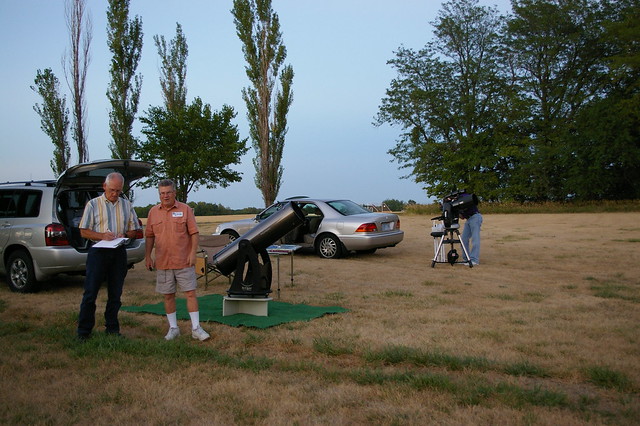
My dad contacted me Thursday to coordinate conveyances for our weekend astronomical adventure, thinking we would be attending the monthly ASKC club meeting, but he was a week early. Since I had mentioned earlier in the week a desire to see the glorious summer spread of our own Milky Way Galaxy, he had called me several times the past few days to see about driving to northern Atchison county to escape the Kansas City area light pollution. Both Wednesday and Thursday evenings turned out to be hazy and cloudy, so we nixed the road trip north.
Instead, I suggested we attend the monthly star party at Powell Observatory. I received two confirmation e-mails from David Hudgins, the club’s star party coordinator extraordinaire. I decided to leave my scope at home because you don’t really need a scope to take in the Milky Way Galaxy. If the skies grew dark enough, it would stretch from the southern horizon, up over the top, clear to the northern one.
I thought perhaps I was reliving last Friday (that would be the 13th) because when I got home early (by ten minutes) I walked into some surreal drama. I won’t go into the stressful week at work (we’ve all had weeks like that), but I looked forward to forgetting work and ignoring the excessive heat by reading books and watching movies in a quiet, air conditioned home with my hubby and two Rotties. I came home to find our satellite on the fritz and Terry needing me to pickup a prescription before the pharmacy closed at seven. While he cooked dinner, I did some preliminary troubleshooting of the satellite system with little success and decided to call DirecTV customer service, knowing I’d probably be on hold for several minutes. The technician wanted us to disconnect, check and reconnect all of our cables, which seemed a ridiculous request since the cable runs are static and have not been touched, moved or manipulated in years. After almost ruining supper in an effort to jump through DirecTV tech support hoops, we hung up on them and sat down to eat.
By now, I had less than an hour to pickup the prescription, so I grabbed my purse and drove to the store. I got as far as the pharmacy counter, where the assistant recognized me and had the prescription ready for me, but when I opened my purse, my billfold was missing. I had left it in the van because I stopped at Starbucks after work for a mocha frappacino treat for the drive home. Now I had to return home for my billfold and repeat the trip back to the pharmacy, a wasted trip, time and gas. When I returned home the third time, Terry had solved the satellite system glich. With our excessive heat and drought conditions, the ground supporting our satellite dish pole has dried up so far down into the ground, that the pole can now be easily moved back and forth and twisted on it’s concrete base. One of our dogs could have bumped into it and messed up the alignment. Terry used the signal strength meter diagnostics channel on the satellite receiver to dial the dish back in.
Hoping that would be the final challenge of the week solved for the moment, I called Dad just after seven o’clock and told him to head my way. I gathered up my camera equipment, my pocket star atlas, a large hardcover edition of Backyard Astronomy (to review Milky Way info), my purse (with billfold) and a lidded glass of cool water. I asked Dad to drive this weekend, volunteering to drive next weekend for the July club meeting. The hour jaunt to Louisburg passed quickly and we arrived at Powell just moments after sunset. The evening cooled off nicely, but remained calm, clear and surprisingly dry. In fact, we experienced no dew (the bane of telescope optics) until after midnight.
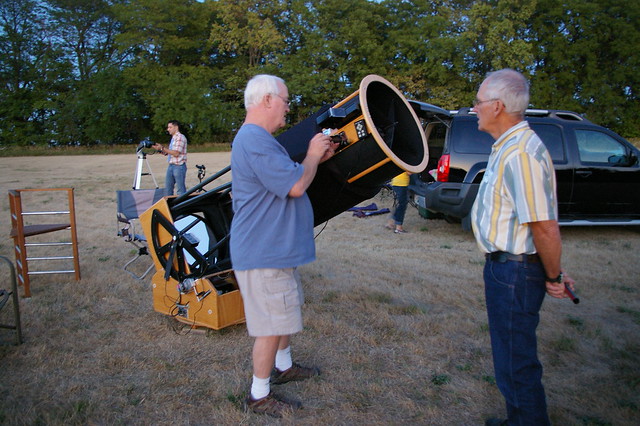
Several club members were already present and setting up their scopes in the East Observing Field (click photo above for photos taken upon our arrival). One member, Mike Sterling, introduced himself to me (asking if I was ‘the’ Jon Moss … apparently my name is known, if not my face or gender, from my blogging). He was in the process of collimating his 20-inch Dobsonian. My dad provided an extra pair of eyes to help finish. Mike also gave us a color brochure published by Astronomy magazine of the illustrated Messier catalog. This will come in handy in the future when I really get serious about an observing award.
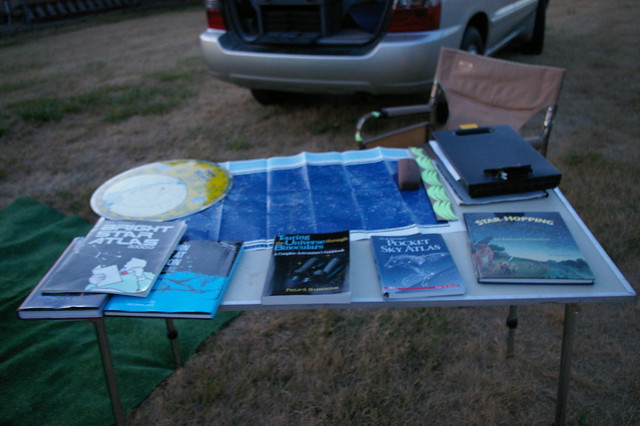
The theme for this month’s star party centered around star charts and atlases. David Hudgins setup a table displaying several popular and easy-to-use books, visual aids and posters. I indicated to David I already owned the Sky & Telescope Pocket Sky Atlas and a smaller version of the wheel night sky star guide (the circular atlas resting on top of the poster in the upper left hand corner of the table shown in the photo above).
Dad and I wondered among the scopes, waiting for twilight to fade and the stars to emerge. Saturn and Mars, along with Spica and Arcturus appeared very early and most of the scopes honed in on our ringed neighbor. By 10:30 pm, the skies had darkened enough to begin hunting for some of the brighter Messier objects. Mike graciously asked me (several times over the course of the evening) what I wanted to observe next. I drew a blank every time because my goal had been to see the Milky Way, not any specific object viewable in a scope. He obligingly filled in the blank by touring through clusters, nebulae and a galaxy found in the constellation Sagittarius, Scorpius, Hercules and Ursa Major. I tweeted the objects as we found them so I would have a record of what we saw and when.
- 10:30 pm – M57 (the Ring Nebula), M20 (the Trifid Neblua), M8 (the Lagoon Nebula), M7 (the Ptolemy Cluster)
- 10:50 pm – M51 (the Whirlpool Galaxy)
- What happened during the 11 o’clock hour? *see update below
- 12:00 am – M4 (globular cluster in Scorpius)
- 12:08 am – M13 (the Great Globular Cluster in Hercules)
- 12:24 am – M10 (globular cluster in Ophicuhus)
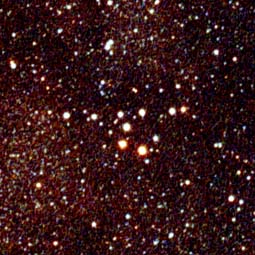
My dad and I also used his binoculars just to see what we could see with them (as opposed to a scope). The highlight of that side project included finding Brocchi’s Cluster (more commonly known by the asterism ‘the Coathanger’). One of the other club members used the Summer Triangle as an aid to locating the Coathanger. As stated in the Wikipedia article: “It is best found by slowly sweeping across the Milky Way along an imaginary line from the bright star Altair toward the even brighter star Vega. About one third of the way toward Vega, the Coathanger should be spotted easily against a darker region of the Milky Way. The asterism is best seen in July-August and north of 20° north latitude it is displayed upside down (as in the picture above) when it is at its highest point.”
* Update * (added after original publication):
I completely spaced out tweeting during the eleven o’clock hour. During this time, Mike disconnected the Goto electronics on his telescope and set me to star hopping for objects near Sagittarius. The first one he tested me with was finding two small globular clusters a small hop away from the gamma star in Sagittarius (the star the delineates the spout of the teapot). If I could find these two clusters, Mike told me I should be able to see both of them at the same time in the eyepiece’s field of view. After about five minutes, I spied a couple of small fuzzy balls, not as distinct as the surrounding background stars, but I thought they might be the clusters. Mike confirmed I had found them by doing a ‘happy dance’ and sing-songing ‘she found them, she found them’ for all to hear. The designations for these clusters are NGC 6522 and 6528.
Mike next set me to finding either M69 or M70 (also hanging out in Sagittarius, but in the bottom of the Teapot). I glanced at his star chart and used his excellent Telrad finderscope (which had a nice large field of view and an easy-to-use red bullseye) to quickly locate one of the Messier objects (probably M69). Again Mike did a happy dance and song.
Mike went looking for another globular cluster, this time between Sagittarius and Scorpius, designated as NGC 6380. I found this one especially interesting because of it’s apparent close proximity to a star.
The third test proved my undoing. Mike moved his scope to Antares in Scorpius and set me to finding M4. I didn’t review his star chart and spent several minutes attempting to find it. Eventually, I gave up and Mike located it.
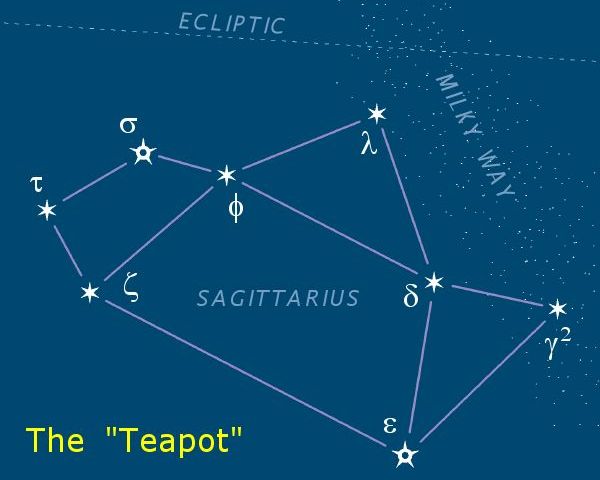
Despite all the mesmerizing Messier distractions, I did succeed in observing the vast sweep of our Milky Way Galaxy. I learned a couple of cool memory aids and bits of trivia about finding the ‘heart’ of the galaxy and the path it takes. Cygnus, the swan constellation, also sometimes known as the ‘Northern Cross,’ flies along the Milky Way, pointing directly to the heart of the galaxy. To find the Milky Way’s heart, locate the Teapot (an asterism for the constellation Sagittarius), visible along the southern horizon during July and August, and imagine steam rising from the spout.
I even attempted to photograph the Milky Way using my simple tripod and DSLR camera, but without an equitorial mount of some kind with a tracking system and the digital photo editing software (to stack multiple repetitive exposures), the best I could accomplish was a three or four second exposure (using ISO 800) and fiddling with the brightness/contrast after downloading:

appears centered/parallel to the frame of the photo).
I also took photos of Cygnus swimming in the Milky Way, the Summer Triangle, the Big Dipper over the dome of the observatory and several of the southern horizon. To see the entire album, click on the photo at the top of this blog.
Soon after 12:30 a.m., Dad and I thanked Mike Sterling for the guided tour of the summer sky. We packed up our gear and drove the hour home, where I finally drifted off to sleep after two o’clock with visions of Messier objects dancing in my head.
Dad and I had a blast and my husband is now having second thoughts about staying home last night. Many thanks to David Hudgins, Mike Sterling and the other members of the Astronomical Society of Kansas City for throwing a fun mid-summer star party.
